Oldest Pictures Of Chavadi (Shirdi)
Chavadi is very important place in Shirdi as Baba used to spend alternate nights, during the last decade of his life. Every alternate night Sai Baba was taken in a procession from Dwarkamai to Chavadi, which is beautifully described in the Blessed book Sai SatCharitra (Chapter XXXVII).
Even these days the procession takes place every Thursday, in Baba Nagri Shirdi at 21:15 PM . The picture of Sai Baba, which is placed on a silver throne in the right side of the Chavadi (here Sai Baba used to sleep), is placed near the Samadhi near the foot of Sai Baba’s Statue. Also Sai Baba’s footwear and Satka, which he used while he was in body are placed near the Samadhi of Sai Baba.
At 21:15 pm garlanded portrait Baba is reverently carried by the great grandson of Tatya Kote Patil, the son of Baijabai, who used to search for Sai Baba in jungles, and feed Baba, who used to roam about in near by jungles. Sai Baba called Baijabai as her sister and Tatya Kote Patil, used to call Sai Baba as Mama. Also mentioned in Sai Sat Charitra is that Tatya Kote Patil used spend nights in Dwarkamai with Sai Baba and other Devotee Mahlsapati Ji. Bhagat Mahlsapati shouted “Ya Sai / Aao Sai ” (welcome Sai), when Sai Baba first came to Shirdi, with the marriage procession of Chand Patil’s wife’s brother’s son, and alighted at the foot of Banyan tree Khandoba Temple.
The great grandson of Tatya Kote is preceded by one of the Mandir staff carrying the Satka and the Padukas (footwear of Sai Baba). The procession moves to the Dwarkamai with sounds of drumbeats and other musical instruments, very similar to the description provided in Sai Sat Charitra. In Dwarkamai the Portrait is placed on silver throne and Bhajans are sung in much festive moods for 15 minutes. Then the portrait is again carried in the palanquin and with much music and Bhajans and shouts of victory to Sai, fire crackers bursting. In such festive environment the palanquin is parked outside the Chavadi and the portrait is carried to the silver throne and aarti is performed.

Sai Baba's Portrait In Chavadi placed where Sai Baba used to Sleep every alternate nights* Sai Baba started sleeping in Chavadi around 1909, when one stormy night it was raining very heavily and the masjid walls were leaking. The devotees asked Sai Baba to move in other place, to which He was resistant. Eventually the devotees virtually forced Sainath Maharaj by half picking him up and carrying him to Chavadi, since then Baba, spent every alternate nights in Chavdi.
* Chavadi is also significant as the formal worship of Sai Baba was Started there. The night Sej arati was started in Chavadi upon arrival of Sai Baba from Dwarkamai and later morning Kakad Arati was offered to Sainath Maharaj when he woke up.
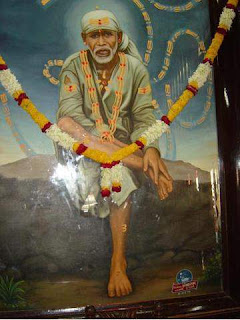

* Chavadi is also significant as the formal worship of Sai Baba was Started there. The night Sej arati was started in Chavadi upon arrival of Sai Baba from Dwarkamai and later morning Kakad Arati was offered to Sainath Maharaj when he woke up.

As we enter the Chavadi we have the Darshan of the portrait above. This portrait was painted by a devotee name Ambaram, from a small town Navsari, which is very near to the writers home town Surat. The devotee was blessed by Sai Baba's darshan in dream in 1953, when he was only 18 years old. The navsari people being touched by Sai Baba's picture by Ambaram, collected donation, bought the portrait, and brought it to Shirdi.
* Right Hand side, where Sai Baba Used to Sleep, he also used to call his Guru's place. Here females were not allowed, that custom is still maintained and only male Devotees can enter this section. Devotees are found bowing in reverence to Sai Baba's Photo, praying, few devotees also sit there and chant Mantras and remember Baba. It has been one of the favorite place of the writer. i spend much time sitting here in silence. The energy level here is really amazing.
The word Chavadi means meeting place of the villagers. Every village in Maharashtra has a Chavadi. The men gather together in the evening to chat wherein they discuss about their crops, their cattle and solve any problem that the village might have. There are two Chavadis in Shirdi; one is south facing where Baba slept on alternate days. Due to a violent storm the devotees forced Baba to sleep there, as the masjid would not withstand the storm’s fury. Baba refused, but perceiving the love and concern of his devotees, he finally agreed. Hence, he stuck to his routine so every alternate day he slept in this Chavadi. The Chavadi procession is described in the Shri Sai Satcharitra Chapter 37.
The other Chavadi was north facing, this was used as a reading room. But it is closed and not in use now.
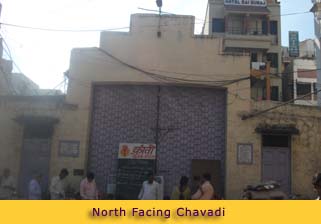
In Shirdi, as in any small village the villagers brought their problems to Baba. It was here that Baba took decisions on true and false statements and acted on the Paap (sinful acts) and Punya (good or righteous deeds). The devotees for their well-being and welfare, made him to go to the Chavadi. Baba did this leaving his tranquil Samadhi state of the Dwaraka Mai. Chavadi is the place for introspection; a court where we have to judge for ourselves and take decisions on what needs to be corrected.
On entering this south facing Chavadi, one can see a plaque on which is inscribed "Shri Sai Nath Babanchi Lakshmi Bai Damodar Babre, Chinchanikar Chavadi, Saka 1859".Damodar Babre came from the village Chinchani in Thane district. Hence, every one called him Anna Chinchanikar. He and his wife came and lived in Shirdi, and were devoted to Baba. For many years they did nishkama seva (selfless service) not expecting or asking for any favours from Baba. One day Shyama asked Baba why He had not blessed this couple with a son while other devotee’s were blessed and their wishes were fulfilled. Baba smiled and said "Has it ever happened, that whenever anybody has asked me for any thing, that I have not granted it"? Baba being Antaryami saw that the son would only continue the name of Anna for one generation. While Baba wanted Anna's name to last for a very very long time.

A civil suit regarding his fields was then in progress at Dahanu. Anna time and again asked Baba about the outcome. Baba always replied"Allah Bhala Karega". A famous lawyer, Achyut Narayan Khare, was handling his case. Once someone maliciously wrote to Anna saying that he had lost the case. Anna ran to Kaka Saheb Dixit and informed him; so, both of them came to Baba at Dwarakamai. As they were entering the Dwarakamai, Baba shouted "This old man has no faith in Me, throw away that letter".
Later the lawyer informed him that he had won the case and Rs. 1,800/- along with the court costs was awarded to him. Anna and Kaka Saheb Dixit then went to Baba with the letter in hand. Baba calmly said "Have you got faith in Me now?" Anna placed the letter at Baba's feet and said "Baba this is all yours, I do not want it". Baba refused to accept the money saying that He was a Fakir. Anna begged Baba to accept it. This conversation went on for some time. Ultimately Kaka Saheb Dixit suggested that the sum could be used to repair the Chavadi, and it should be named after Anna and his wife Lakshmi Bai.
In the 1920’s, the Chavadi was a building with three steps leading to it. It had three doors facing south. Then two verandahs were added on either side of the steps. The verandahs are about 13’ long and 8’ wide. In the 1970s, the grills were added. On the Chavadi procession the day’s Arati was performed to Baba, and then Baba was given the chillim to smoke. Now a photograph of Baba is placed on a silver throne (simhasan) and Arati, performed to it. The paintings of the leelas and stories of various Gods and Goddesses were there from Baba’s time.
In the 1920’s, a glass box was placed in front of the photograph with Baba’s padukas in them. This box was there till the 1970’s. In the 1970’s, there were two pairs of padukas kept open for darshan. Then the padukas were kept in the show room of the Samadhi Mandir. After the museum was opened the padukas were kept there. After Baba’s Samadhi, the Chavadi procession is being held by the Sansthan on every Thursday’s and on festival days.
On 9th December 2008, it was the dawn of the 100th year of congregational Arati and palanquin procession. The Shirdi Sai Baba Sansthan had a grand celebration. After Baba’s mangal snan at 6:45 a.m. there was a grand procession, the silver padukas were brought from the Samadhi Mandir to the Chavadi. There Aarati was performed, this was followed by reading of the 37th Chapter of Shri Sai Satcharitra. This chapter has the title “The description of the Chavadi Ceremony”. The villagers along with numerous devotees did “samoohika pathana” (collective reading) of Das Ganu’s Stavana Manjari. Then there was Maha Prasad given by the Sansthan.
CHAVADI PROCESSION
Since 10th December, 1910 devotees began to offer regular worship to Baba in this Chavadi. They brought Him in procession in a regal and royal manner from the Dwarakamai to Chavadi. Even today on Thursdays and other festival days the procession can be seen.
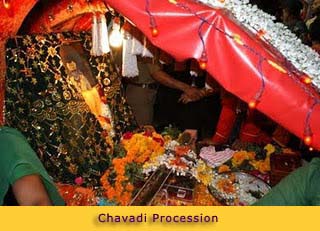
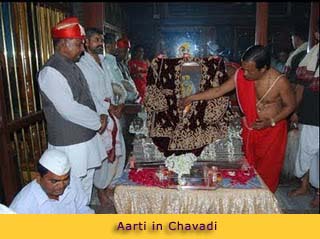
10th December 2010 marked 100th year since the night Arati at Chavadi commenced (Refer Sai Satcharitra Chapter 4 - The story of three wada’ s where in it is stated that the night Arati at Chavadi began on 10th December 1910). The following Arati’s are being specially sung at Chavadi on Thursday’s night (apart from Shej Arati that is performed at Samadhi Mandir)
It is taken to the Samadhi Mandir, every Thursday in the afternoon and on other holy days like Ramanavami, Gurupurnima, Vijayadashami. There it is placed on the Samadhi. After Dhoop Arati at 8:45 PM it is taken from Samadhi Mandir in the Palki Procession.
It is the only photograph that has been clad with a Silk Shawl. Baba’s photograph is taken to the Samadhi Mandir where the Pujari does Panch Upachar. The photograph is applied with Gandh or Sandalwood Paste. It is offered Pushpa (flowers), Dhup (Incense), Deepa (Lighted Lamp) and Naivedyam (Offering of food). Then the photograph is clad with the Silk Shawl.
This photograph has been there since Baba's time. Every Thursday after the noon Arati it is brought out and kept on the wooden cot for darshan. Then it is taken to Samadhi Mandir, where after Raj Upachar it is taken in the Palki along with Baba's Padukas and Satka. Arati is done in the Chavadi, and chillim is offered to Baba in this portrait, then taken back to Samadhi Mandir for Shej Arati. It is brought back to the Chavadi, after Kakad Arati the next day.
Chavadi is the place where Baba slept every alternate night. The question that comes to devotee’s mind is “Why did Baba sleep in the Chavadi on alternate nights?”.
The sleeping should be understood at a higher parlance, that is, a state of Samadhi or a rehearsal of death. In death one is alone, as neither spouse nor the children will accompany us. Baba by doing this himself taught us this truth.
Another Question that arises in devotee’s mind is “why women are not allowed in the Sanctum Sanctorum of the Chavadi?”.
The Chavadi is the soul or core of the Jeeva. The human nature is attracted to Kamini, Kanchana and Kashyap. By following this rule strictly, Baba is teaching us not to be trapped by sexual lust. To look at women as mother will ensure spiritual advancement.
Hence, Shri Shirdi Saibaba Sansthan has restricted the entry of female Sai Devotees to the area in Chavadi where Saibaba used to sleep. Female Sai Devotees should strictly follow this rule when they visit Shirdi for Saibaba Darshan.
THE WOODEN COT
After Baba took Mahasamadhi on 15th October, 1918, (Tuesday) at 2.30 PM His body was laid on this wooden cot for three days, till 17th October, 1918 (Thursday). As there were differences between His devotees as to where to intern Him (Ref. ESS, Ch. XLIII & XLIV), on this wooden cot His last bath was performed. With due formalities His body was brought in procession to Dagdi Wada (Samadhi Mandir). In the Garbha Gruha or Santrum Sanctorum i.e. the central portion which was reserved for installation of Murlidhar Idol his Samadhi was made.
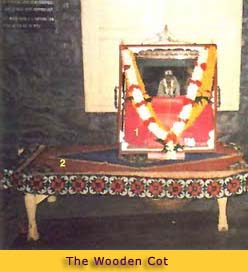
This cot was earlier in Dwarakamai but later housed in the Chavadi. This was placed in North West Corner of the Chavadi where ladies are allowed to go. Every Thursday it was taken out and placed in front of the Chavadi and Baba's palki is placed on it. After Arati this cot was placed back along the north western wall of the Chavadi.
But, after the Museum was built, this Wooden Cot was moved there. It is now displayed on the ground floor, in the central area of the Museum.
THE WHEEL CHAIR
In 1886 Baba made an attempt to cross the borderline. He suffered from a severe attack of Asthma, and to get rid of it He took samadhi for 72 hours. Mahalsapathi guarded His body well (Ref. ESS, Ch. XLIV). Baba coughed off and on. This chair was presented by a devotee, for Baba to use, and move about in His old age. However, Baba moved freely and occasionally with the help of His devotees. Baba did touch this chair, and kept it, but never made use of it. This chair was placed on the north-western corner of the Chavadi next to the Wooden Cot.
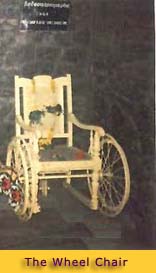
But, after the Museum was built, this Wheel Chair was moved there. It is now displayed on the ground floor, in the central area of the Museum.
THE GLASS LAMPSHADES (GLASS GLOBES)
Radha Krishna Mayi was a young widow who hailed from Pandharpur. She heard about Baba’s leelas and divinity from Chandorkar. She came to Shirdi and made it her home.
Radha Krishna Mayi loved loved Baba and wanted Him to have a royal Sansthan, which would take care of all the silverware and fine cloths. She tirelessly worked to this end, and often asked rich devotees to bring beautiful articles for Baba. She wanted Baba to enjoy the pomp and show like Lord Vittal of Phandharpur. Kaka Mahajani on the advice of Radha Krishna Mayi brought these glass globes for Baba's lamps in Chavadi. Govardhan Das brought silk curtains and new uniforms for the volunteers who carry the umbrella and chamars (Refer Shirdi Diary, Page.30 by Khaparde).
The daily routine at the Chavadi is given below for the benefit of Sai Devotees:
THURSDAY CHAVADI PROCESSION DETAILS:
The “Pitambar” of the “Raj Upachar” photograph is changed with due formalities at about 4.40 AM.
After Noon Aarti at about 12.40 PM the Raj Upachar photo is brought and kept in the Samadhi Mandir. Here this photo is placed along with the Padukas and Satka on the platform of the Baba’s Samadhi.
At 9:15 PM the Chavadi Ustav commences at Samadhi Mandir with the chanting of the below mentioned devotional bhajans:
Alankapuri punya bhumi pavitratithe nandato dnyanraja supatra taya aathavita mahapunya rashi namskar maza shri sadguru dnyaneshwarasi. Pundalika Varade hari vittala, Sri Janadeva, Tukarama, Pandarinath Maharaj Ki Jai, Sadguru Sainath Maharaj Ki Jai. Jai Jai Ram Krishna Hari Jai Jai Ram Jai Jai Ram Krishna Hari Jai Jai Ram Krishna Hari Jai Jai Ram Sai Hari Jai Jai Ram Jai Jai Ram Krishna Hari Roopa Pahatam Lochaanim. Sukha Jalem Vo Sajaani. To Ha Vittala Barava. To Ha Madhava Barava. Bahutam Sukrutanchi Jodi Mhanuni Vittalim Aavadi. Sarva Sukhachem Agara. Baapa Rakhumaadevivaroo.
Then the procession proceeds from Samadhi Mandir with the chanting of other bhajans and reaches Dwarakamai around 9:20 PM.
The procession arrives inside Dwakramai around 9:20 PM. The Rajopachar Photograph, Sri Sai Baba’s Paduka and Satka are placed on the Stone on which Baba used to sit. Then the below mentioned devotional bhajans are sung:
Alankapuri punya bhumi pavitratithe nandato dnyanraja supatra taya aathavita mahapunya rashi namskar maza shri sadguru dnyaneshwarasi. Pundalika Varade hari vittala, Sri Janadeva, Tukarama, Pandarinath Maharaj Ki Jai, Sadguru Sainath Maharaj Ki Jai. Jai Jai Ram Krishna Hari Jai Jai Ram Jai Jai Ram Krishna Hari Jai Jai Ram Krishna Hari Jai Jai Ram Sai Hari Jai Jai Ram Jai Jai Ram Krishna Hari Roopa Pahatam Lochaanim. Sukha Jalem Vo Sajaani. To Ha Vittala Barava. To Ha Madhava Barava. Bahutam Sukrutanchi Jodi Mhanuni Vittalim Aavadi. Sarva Sukhachem Agara. Baapa Rakhumaadevivaroo. Sai Nama Sukhadaayi Sai Nama Ke Do Akshar Mein Sab Sukh Shanti Samaayi Sai Nama Sukhadaayi Hindu Muslim Sikh Isaayi Sabhko Laage Aas Tumhari Ashish Dekhar Pavan kardo Badavo naam ki aas tumhari Sai Nama Sukhadaayi Har Dam Tu He Mere Saath Heen Deen Ka Ekhi Naath Saidham Ki krupa Hogayi Pavan Hogayi Kaya Meri Sai Nama Sukhadaayi Gopalan Hein Kya Kamal Teri Pani Mein Tu Jyoth Jalayi Pani Mein Tu Deep Jalayi Naa Man Bhoole Tera Koi Shirdiwaale Baba Sai Sai Nama Sukhadaayi
Sunder Te Dhyan Ubhe Vitewari.
Shirdi Majhe Pandarapura Sai Baba Ramaavara.Kar Katawari Thehuniya. Tulasi Hara Gala Kanse Pitambara. Aawde Nirantara Hechi Dhyana. Makara Kundale Talapti Shrawani Kanti Koustubhmani Virajita. Tuka Mahne Majhe Hechi Sarva Sukha. Aa Pahin Shrimukha Aawadine. Shudha Bhakti Chandrabhaga Bhava Pundalika Jaga. Yahoyaho Avaghe Jana Karu Babanchi Vandana. Ganu Mhane Baba Sai Dhav Pav Majhe Aayee. After the above devotional bhajans, the Rajaopachar photo is brought from the stone on which Baba sat and placed inside the Palanquin.
Then the Goshana Lalkari is sung by Chopdaars as below:
“Shri Gurudeva Shrimanta Maharaaj, Sadguru Sainath Maharaj Ki Jai”
Meaning: Shri Gurudeva (Datta) richest of the richest Shri Sadguru Sainath Maharaj Ki Jai.
Then the Procession starts from Dwarakamai around 9:30 pm with the below bhajan:
Sainatha Guru Majhe Ayi Majala Tava Dhyava Paayi
Majala Tava Dhyava Paayi, Majala Tava Dhyava Paayi
Sainatha Guru Majhe Ayi, Majala Tava Dhayava Paayi
The procession reaches Chavadi around 9:35 PM.
On the arrival of the Palanquin from the Dwarakamai to Chavadi, it is placed on Baba’s cot, which is kept in front of the Chavadi. On this cot Shri Sai Baba's body was kept for 3 days after he attained Mahasamadhi on 15th October 1918. This was followed till the year 2006-2007. But after Shri Sai Baba Sansthan started the Museum in the erstwhile Dikshit Wada, they decided to keep all the original articles used/related to Shri Sai Baba in Museum with a view to preserve them for a longer period of time. Hence, the original cot was kept in the ground floor of the Museum and sealed with a glass cabinet. Now the Sansthan uses a replica of the cot on which Shri Sai Baba's Palanquin is kept.
On every Thursday, after the evening Dhoop Aarti the place in front of Chavadi is thoroughly washed and a big and beautiful Rangoli will be put by a local Sai devotee. When the Palanqin procession comes near Chavadi, The cot and the Palanquin would be placed on the Rangoli with due respect.
The descendants of Tatya have the honor to carry Baba’s photo from the Palanqin into the Chavadi and place it on the Simhasan, while Bayyaji’s descendants carry the Padukas and Satka into the Chavadi for Aarti.
The Rajopachar Photograph of Sai Baba, Paduka and Satka will be placed in the right side of Chavadi where Sri Sai Baba used to sleep every alternate day. Then Dhoop and Panchaarti Deep is offered to Sri Sai Baba followed by Upahara Naivedya.Ater the Naivedya Aarti is performed to Sri Sai Baba.
The Laghu (small) Aarti is performed from 9.30 PM to 9:45 PM. At the beginning of the Aarti “Shri Sachchidananda Sainath Maharaj Ki Jai” is uttered.
Then the below 5 Laghu Aartis are sung:
1. Ghevuniya Panchaarati
2. Aarati Saibaba 3. Shirdi Majhe Pandharapura 4. Ghalina Lotangana 5. Hare Rama Hare Rama
While Aarati Sai Baba is sung the Chillum is offered to Sai Baba Rajopachara Photograph. It is believed that even today during Chavadi Aarti time, Baba comes and smokes the Chillum. If a devotee closely observe when chillum is offered to Baba’s photograph, the flame automatically rise very high as if someone is smoking the Chillium. This is none other than our beloved Sadguru Sai Baba because Baba liked smoking Chillum very much.
At the end of Aarti at Chavadi the Chopdaars utter “Sri Guru Deva Datta”. Then the Goshana Lalkari is sung by Chopdaars as below:
“Shri Gurudeva Shrimanta Maharaaj, Sadguru Sainath Maharaj Ki Jai”
During Shri Sai Baba's sojurn in Shirdi, Tatya used to follow the tradition of applying Attar and Rose Water on Shri Sai Baba during Palanquin procession. (Shri Sai Satcharitra Chapter 37). The same legacy is continued even today by Shri Sai Baba Sansthan Trust (Shirdi) and after the completion of Aarti at Chavadi, descendants of Tatya will apply Attar (Perfume) and Rose Water on Shri Sai Baba's Rajopachar Photograph before it is taken out from Chavadi in procession to the Samadhi Mandir.
The around 9:45 PM the Rajopachar Photo, Paduka and Satka is removed from Chavadi and taken in a Palanquin procession throughout the shirdi village.
After the Chavadi Aarti when the Palanquin and the cot is removed, all the devotees rush towards the Rangoli drawn area and apply the Rangoli on their body thinking that the Rangoli powder is sanctified by Baba since HE sat on that and that by applying the Rangoli powder on their bodies, they will be purified.
Later the Palanquin procession comes back in the end to Samadhi Mandir at 10:30 PM for the Shej Aarti. In this way, the Palanquin returns with the Rajopachar Photograph and Padukas to Samadhi Mandir. The Chavadi closes at about 9:45 PM.
The Chavadi Utsav tradition, the Lalkari Goshana was stared during the sojourn of Shri Sai Baba by none other than Sai Mahabhakte Late Smt.Radhakrishna Maayi on the lines of the tradition that was being followed at Phandarapur for Lord Vittal. She even selected special dresses that used to be put on Sri Sai Baba. Late Smt.Radhakrishna Maayi wanted Sai Baba to be treated on par with Lord Vittal of Pandarapur.
The Rajopachar Photograph comes back to the Chavadi after the Kakad Aarti of the next day.
| ||||||||||||
(Source : Ambrosia in Shirdi and Baba’s Gurukul by Shri Vinny Ji Chitluri )
|
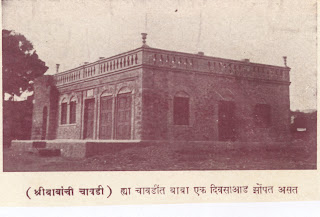
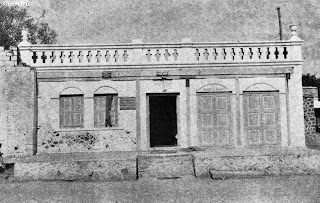
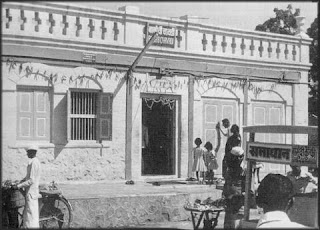






No comments:
Post a Comment